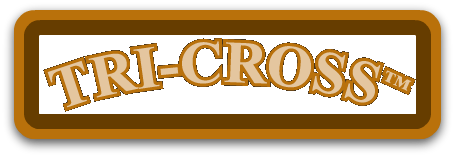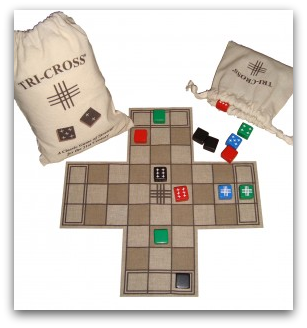
What do you get when you combine the strategy of chess and the simplicity of checkers? Tri-Cross from Games for Competitors.
I was supplied with two editions of Tri-Cross for review. Both play the same and differ only in matters of storage and portability. The Tri-Cross Standard Edition, which includes a folded playing board and 20 playing pieces, is the typical style of a boxed board game.

The Tri-Cross Eco-Friendly Travel Edition has the same 20 playing pieces, but the playing board is cloth and folds into a smaller square. Everything fits conveniently in a drawstring cloth bag. This version is made of organic-cotton and non-toxic inks. The size of the board and bags were also reduced, making it both eco and travel friendly.

Tri-Cross is intended for 2-4 players, ages 10 and up. There are also several versions of play, from beginning to advanced. Players need to strategically move their pieces, which have different playing power, around the board challenging and jumping the pieces of others. In order to win, the player need to accomplish just one of two goals: jump all the pieces of the opposing player(s) or occupy the center square with any piece for four turns in a row. Below is a video explaining the most basic game (called the Face-Up Version).
If it seems simple to learn and play, it is because it is exactly that. We found the Face-Up Version of play to not be overly challenging. There is strategy involved, but it comes down to who can best place and play two critical pieces, the "tri-cross" and the "six". Since the "six" is the most powerful pieces on the board, but can be also be jumped by the "tri-cross", the otherwise weakest piece on the board, players need to pay special attention to both of these pieces and the board center. This version was a very quick game, though we only played with two people. I imagine it would have gotten more lively with additional players, introducing more critical pieces to watch for and challenge.
The Face-Up Version is intended more as a way to introduce how the game works and develop some basic strategy. Things get a bit more challenging with the Standard Version of play, where the pieces are initially placed face-down. Players not only have to remember the power of the face-down pieces until a challenge (when they are turned face-up for the remainder of the game), but they don't have knowledge of the power of their opponent's pieces before a challenge. There are three variations of the Standard Version, Guts, Reverse Guts, and Team Play, which differ on the beginning knowledge of the power of the pieces played on the board. You can see a video explaining the Standard Version of play and its variations here.
Tri-Cross develops many skills that we all desire in our children (and ourselves!), including logical thinking, cause and effect, predicting, interpreting outcomes, abstract thinking, memory and visualization. One of the more difficult things for my son, who tends to make quick decisions, was to anticipate the following moves. I saw his strategy improve as he learned from his mistakes. While Tri-Cross can be a simple game, as the strategy of the players increases and different variations are applied, it becomes more challenging.
I really appreciated the simplicity of learning how to play Tri-Cross. I dislike games that have numerous and complicated rules, requiring just as long to learn the game as it takes to play. Yet, the simple to learn doesn't mean simple strategy. We only played the game one-on-one, but once we started playing pieces face-down, I quickly realized how I needed to make better use of my brain ("Let's see...is this piece my "6" or this one? Oh - why is he moving that piece there? I wonder if he's going to challenge that piece over there. Uh oh...that is only a '3'. Perhaps I need to move it. ") Like chess, the game requires more strategy than luck, and I would suggest that players be more evenly paired in strategy skills. My son initially got frustrated that I was further along in the strategy, but as soon as I started to give him some pointers and guide his cause and effect thinking, he was able to win.
Overall, we enjoyed this game. It is simple, yet challenging, and it doesn't take forever to play. I can see why Tri-Cross has been referred to as the "new chess".
Both editions, in addition to a wood version, are available at the Games for Competitors website. While you are at the website, check out the About Us page that shares how the Tri-Cross was reintroduced after 20 years from its original debut (a great family story!). The Standard Edition sells for $24.95, and the Eco-Edition for $19.95.
Want to see what others think about this product? Visit the official TOS Crew blog to read more reviews on Tri-Cross.
Disclaimer: This review was provided as a result of my participation in The Old Schoolhouse Magazine Crew. I was provided the product free of charge in exchange for my honest review. I have received no other compensation. I strive to give a balanced overview of each product, detailing my opinion of both pros and cons and how the product worked for my family. What works for one family may not work for another. I encourage you to read reviews of other Crew members and research sufficiently to determine if any product will be a benefit to your homeschool.
No comments:
Post a Comment